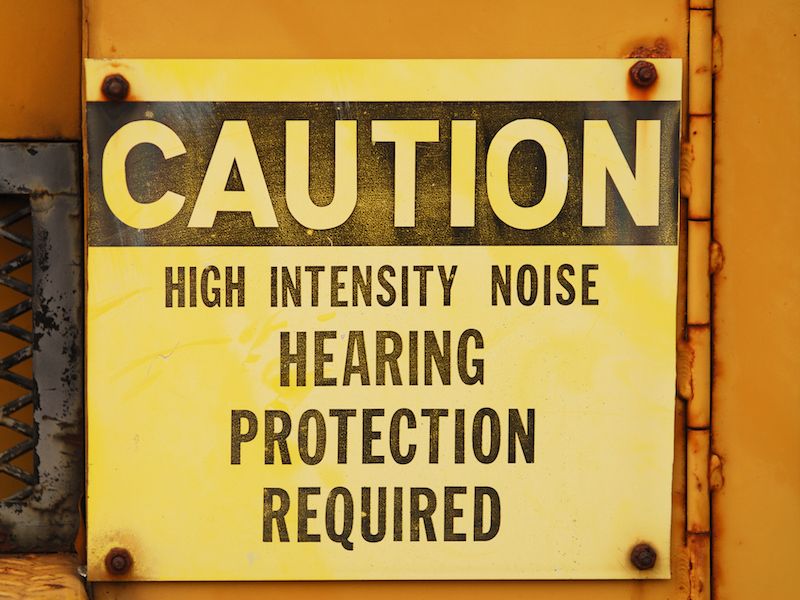
Realizing you should safeguard your hearing is one thing. Recognizing when to protect your ears is another matter. It’s more challenging than, for instance, knowing when you need sunblock. (Is the sun out and will you be outdoors? Then you need sunscreen.) Even recognizing when you need eye protection is easier (Doing some hammering? Cutting some wood or working with dangerous chemicals? Wear eye protection).
It can feel as though there’s a large grey area when addressing when to use hearing protection, and that can be detrimental. Unless we have specific knowledge that some activity or place is dangerous we tend to take the easy path which is to avoid the problem altogether.
Assessing The Risks
In general, we’re not very good at assessing risk, especially when it comes to something as intangible as damage to the ears or the probability of long term sensorineural hearing loss. To demonstrate the situation, check out some examples:
- Person A goes to a very loud rock concert. 3 hours is approximately the length of the concert.
- A landscaping business is run by person B. After mowing lawns all day, she goes home and quietly reads a book.
- Person C works in an office.
You might presume that person A (let’s call her Ann, to be a little less formal) may be in more hearing danger. For the majority of the next day, her ears will still be ringing from the loud show. Presuming Ann’s activity was risky to her ears would be reasonable.
The noise that person B (let’s just call her Betty), is subjected to is not as loud. There’s no ringing in her ears. So her hearing must be safer, right? Not really. Because Betty is mowing all day. So even though her ears never ring out with pain, the injury accrues slowly. Even moderate sounds, if experienced with enough frequency, can injury your hearing.
Person C (let’s call her Chris) is even less evident. Lawnmowers have instructions that emphasize the hazards of continued exposure to noise. But even though Chris works in a quiet office, she has a very noisy, hour-long commute each day on the train. Additionally, although she works at her desk all day, she listens to her music through earbuds. Does she need to give some thought to protection?
When You Should Worry About Safeguarding Your Ears
Normally, you should turn down the volume if you have to shout to be heard. And if your surroundings are that loud, you need to consider wearing earplugs or earmuffs.
The limit should be 85dB if you want to get scientific. Sounds above 85dB have the ability to result in damage over time, so you should give consideration to wearing hearing protection in those conditions.
Most hearing professionals recommend using a specialized app to monitor decibel levels so you will be aware when the 85dB has been reached. These apps can tell you when the surrounding sound is approaching a dangerous level, and you can take suitable steps.
A Few Examples
Even if you do get that app and take it with you, your phone might not be with you everywhere you go. So we might establish a good standard with a couple of examples of when to safeguard our ears. Here we go:
- Domestic Chores: We already mentioned how something as basic as mowing the lawn, when done often enough, can require hearing protection. Chores, such as mowing, are probably something you don’t even think about, but they can cause hearing damage.
- Exercise: You know your morning cycling class? Or maybe your daily elliptical session. You may think about wearing hearing protection to each one. Those instructors who use microphones and sound systems (and loud music) to motivate you may be good for your heart rate, but all that volume is bad for your ears.
- Working With Power Tools: You know that working all day at your factory job is going to necessitate ear protection. But how about the hobbyist building in his garage? Most hearing professionals will recommend you wear hearing protection when using power tools, even if it’s only on a hobbyist level.
- Listening to music with earbuds. OK, this doesn’t require protection but does require caution. Pay attention to how loud the music is, how long you’re playing it, and whether it’s going directly into your ears. Noise-canceling headphones are a great choice to prevent having to turn the volume way up.
- Commuting and Driving: Do you drive for Lyft or Uber? Or perhaps you’re just hanging out downtown for work or boarding the subway. The constant noise of living in the city, when experienced for 6-8 hours a day, can cause injury to your hearing over the long haul, particularly if you’re turning up your music to hear it over the commotion.
A good baseline may be established by these examples. If there is any doubt, though, wear protection. In most cases, it’s better to over-protect your ears than to leave them subject to possible damage in the future. Protect today, hear tomorrow.

